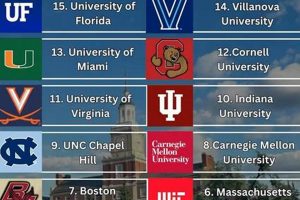Top-tier medical institutions offering Obstetrics and Gynecology programs are characterized by rigorous academic curricula, extensive clinical experience opportunities, renowned faculty expertise, and cutting-edge research facilities. These programs typically include clerkships, rotations, and sub-internships in areas such as prenatal care, childbirth, reproductive endocrinology, infertility, gynecologic oncology, and minimally invasive surgery. A strong emphasis is placed on developing diagnostic, treatment, and surgical skills, along with cultivating compassionate patient care.
Access to high-quality medical education in this specialized field is crucial for addressing women’s health needs across the lifespan. Well-trained physicians are essential for providing comprehensive care, advancing medical knowledge through research, and advocating for improved healthcare policies. Historically, advancements in obstetrics and gynecology have significantly reduced maternal and infant mortality rates and expanded reproductive health options. The continued pursuit of excellence in these programs is vital for maintaining and improving women’s health outcomes.
This article will delve further into the key features that distinguish leading programs, including faculty profiles, research initiatives, and specialized training opportunities. It will also explore career paths and subspecialties available to graduates, along with the evolving landscape of women’s healthcare and the role these institutions play in shaping its future.
Tips for Selecting a Top Obstetrics and Gynecology Program
Choosing the right residency program is a pivotal step for aspiring obstetrician-gynecologists. Careful consideration of several factors can contribute to a successful and fulfilling medical career.
Tip 1: Research Faculty Expertise: Investigate faculty research interests, publications, and clinical specialties. Alignment with individual career goals enhances learning and mentorship opportunities.
Tip 2: Evaluate Clinical Experiences: Seek programs offering diverse clinical rotations, including high-risk pregnancies, gynecologic oncology, and reproductive endocrinology, to gain broad exposure.
Tip 3: Consider Program Culture and Values: A supportive and collaborative learning environment fosters professional growth and well-being. Look for programs that prioritize mentorship and resident education.
Tip 4: Assess Research Opportunities: If research is a career interest, explore programs with dedicated research infrastructure, funding opportunities, and faculty mentorship in chosen areas of interest.
Tip 5: Explore Location and Community: Consider the program’s location, cost of living, and surrounding community to ensure compatibility with personal preferences and lifestyle.
Tip 6: Review Program Size and Structure: Program size can influence the level of individual attention and opportunities for hands-on experience. Consider the program’s curriculum structure and teaching methodologies.
Careful consideration of these factors allows prospective residents to identify programs aligning with individual career aspirations and learning styles. A well-chosen program provides a strong foundation for a rewarding career in obstetrics and gynecology.
By understanding these elements, prospective medical students can make informed decisions that align with their individual career goals and contribute to their success in this demanding and rewarding field.
1. Faculty Expertise
Faculty expertise stands as a cornerstone of top-tier obstetrics and gynecology programs. Distinguished faculty members bring a wealth of knowledge derived from extensive research, clinical practice, and leadership within the field. This expertise directly translates into high-quality medical education, innovative research opportunities, and exceptional patient care. The presence of nationally recognized experts in subspecialties such as reproductive endocrinology, maternal-fetal medicine, and gynecologic oncology elevates the learning environment and fosters a culture of academic excellence. For example, institutions with faculty actively involved in groundbreaking research on minimally invasive surgical techniques offer residents unparalleled training opportunities in these advanced procedures. The depth and breadth of faculty knowledge within a program directly influence the caliber of graduating physicians.
The impact of faculty expertise extends beyond the classroom and into clinical settings. Experienced clinicians provide crucial mentorship and guidance to residents, shaping their clinical skills and fostering a commitment to patient-centered care. Exposure to diverse faculty perspectives and clinical approaches broadens residents’ understanding of complex medical challenges and prepares them for the multifaceted demands of the field. Furthermore, faculty members often serve as role models, inspiring residents to pursue academic careers, engage in research, and contribute to the advancement of women’s health. For instance, a program with a strong faculty presence in global health may inspire residents to pursue international collaborations and address health disparities affecting women worldwide.
In summary, faculty expertise serves as a critical differentiator among obstetrics and gynecology programs. The presence of accomplished clinicians, researchers, and educators enriches the learning environment, fosters innovation, and cultivates future leaders in the field. When evaluating programs, prospective residents should carefully consider the faculty’s credentials, research interests, and clinical specialties to identify programs that align with their career aspirations. The strength of a program’s faculty ultimately contributes to the success of its graduates and the advancement of women’s healthcare.
2. Clinical Opportunities
Extensive and diverse clinical opportunities represent a critical component of top-tier Obstetrics and Gynecology programs. The quality and breadth of clinical experiences directly correlate with the development of competent and compassionate physicians. Exposure to a wide range of patient populations, medical conditions, and treatment modalities is essential for building a strong foundation in clinical practice. Leading programs provide access to high-volume delivery services, complex gynecological surgeries, specialized clinics focusing on areas such as reproductive endocrinology and infertility, and robust outpatient settings. For instance, rotations at a Level I trauma center provide invaluable experience in managing high-risk pregnancies and obstetric emergencies, while exposure to a dedicated gynecologic oncology service offers insights into the diagnosis and treatment of female reproductive cancers. These diverse experiences shape clinical acumen, diagnostic skills, and surgical proficiency.
The structure and organization of clinical rotations significantly impact the learning process. Well-designed programs offer a balance between supervised patient care, hands-on procedures, and opportunities for independent decision-making. Progressive responsibility fosters confidence and prepares residents for the challenges of independent practice. Furthermore, integration with other medical specialties, such as internal medicine, surgery, and pediatrics, provides a holistic understanding of patient care and strengthens interdisciplinary collaboration. For example, participation in multidisciplinary tumor boards alongside medical oncologists, radiation oncologists, and pathologists enhances the management of complex gynecologic oncology cases. Such collaborative experiences cultivate teamwork and communication skills, vital for effective patient care.
In summary, robust clinical opportunities serve as the cornerstone of exceptional Obstetrics and Gynecology training. The breadth and depth of clinical experiences, combined with a structured and supportive learning environment, cultivate well-rounded physicians equipped to address the diverse healthcare needs of women. The strength of a program’s clinical offerings is a key indicator of its commitment to producing skilled, compassionate, and competent practitioners, ultimately contributing to improved patient outcomes and the advancement of women’s health.
3. Research Infrastructure
A robust research infrastructure is a hallmark of leading Obstetrics and Gynecology programs. It provides the foundation for advancements in women’s health, offering opportunities for faculty and residents to engage in cutting-edge research, ultimately improving patient care and shaping the future of the field. This infrastructure encompasses various components, from state-of-the-art laboratories and dedicated research funding to mentorship programs and opportunities for collaboration.
- Funding Opportunities:
Access to substantial research funding, from sources like the National Institutes of Health (NIH) and private foundations, enables investigators to pursue ambitious projects. This funding supports personnel, equipment, and resources necessary for high-impact research. For example, a program with strong NIH funding might enable research into novel treatments for endometriosis or develop innovative diagnostic tools for ovarian cancer. Ample funding translates into greater opportunities for residents to participate in meaningful research projects, contributing to scientific discovery and enhancing their residency experience.
- State-of-the-Art Facilities:
Modern laboratories equipped with advanced technology are essential for conducting sophisticated research. This includes specialized equipment for genetic analysis, molecular biology, imaging, and data analysis. Access to such facilities allows researchers to delve deeper into the underlying mechanisms of disease, develop novel diagnostic and therapeutic approaches, and contribute to personalized medicine. For instance, a program with a dedicated reproductive genetics laboratory could enable research into preimplantation genetic diagnosis and the development of new fertility treatments.
- Mentorship and Collaboration:
A thriving research environment requires strong mentorship and opportunities for collaboration. Experienced faculty members guide residents through the research process, fostering critical thinking skills, and providing valuable insights into study design, data analysis, and publication. Collaboration with other departments and institutions expands research horizons and fosters interdisciplinary innovation. For example, collaborating with engineers could lead to the development of new medical devices for minimally invasive gynecological procedures.
- Dedicated Research Time:
Protected time dedicated solely to research allows residents to fully engage in scholarly activities. This dedicated time signals a program’s commitment to fostering future physician-scientists. It provides residents with the opportunity to develop research projects, analyze data, present findings at conferences, and publish in peer-reviewed journals. This protected time can be instrumental in securing competitive fellowships and establishing successful academic careers. For example, a resident with dedicated research time might complete a project investigating the effectiveness of a new prenatal screening tool, leading to publication and presentations at national conferences.
These interwoven components of a strong research infrastructure are crucial for attracting top-tier faculty and residents. They cultivate an environment of innovation and discovery, directly contributing to advancements in women’s health. Programs with robust research infrastructures play a pivotal role in shaping the future of obstetrics and gynecology by training the next generation of physician-scientists and driving transformative research that improves patient outcomes.
4. Program Culture
Program culture significantly influences the educational experience and professional development within top Obstetrics and Gynecology residency programs. A positive and supportive learning environment fosters collaboration, mentorship, and well-being, ultimately contributing to the development of skilled and compassionate physicians. This culture shapes residents’ clinical skills, research endeavors, and career trajectories. A program prioritizing resident well-being, for instance, might offer resources like mental health support, flexible scheduling options, and protected time for personal pursuits. Such initiatives recognize the demanding nature of medical training and aim to mitigate burnout while fostering a supportive community.
The impact of program culture extends beyond individual well-being to influence the overall quality of education and patient care. A collaborative environment, where faculty and residents work together seamlessly, fosters open communication, shared decision-making, and mutual respect. This translates into enhanced learning opportunities, improved patient safety, and a more positive clinical experience for both residents and patients. For example, a program that encourages interdisciplinary collaboration might establish joint conferences with other specialties like Neonatology or Maternal-Fetal Medicine, enriching residents’ understanding of complex cases and promoting a team-based approach to patient care. Institutions fostering a culture of inquiry and innovation cultivate future leaders in the field by encouraging resident involvement in research, quality improvement projects, and advocacy efforts. Such initiatives equip graduates with the skills and experience to drive advancements in women’s health throughout their careers.
In summary, program culture represents a critical factor in distinguishing exceptional Obstetrics and Gynecology training programs. A supportive, collaborative, and innovation-driven environment contributes significantly to resident well-being, educational attainment, and the quality of patient care. When evaluating programs, prospective residents should carefully consider the prevailing culture, seeking environments that align with their personal values and professional goals. The culture of a program ultimately shapes the future of its graduates and their contributions to the field of women’s health. Understanding this dynamic empowers prospective trainees to make informed decisions that optimize their educational experience and prepare them for successful and fulfilling careers.
5. Career Support
Robust career support is a defining characteristic of top Obstetrics and Gynecology programs, inextricably linked to their ability to produce successful and fulfilled physicians. This support plays a crucial role in shaping career trajectories, facilitating transitions into various practice settings, and fostering leadership development. It encompasses a range of services, including individualized career counseling, mentorship programs, networking opportunities, and assistance with fellowship applications. For instance, programs may offer workshops on contract negotiation, practice management, and leadership skills development. These resources equip graduates with the tools necessary to navigate the complexities of the healthcare landscape and thrive in their chosen careers. Institutions with strong alumni networks often facilitate connections between graduating residents and established physicians in various subspecialties and geographic locations, creating valuable mentorship opportunities and expanding career options. Dedicated fellowship advisors provide personalized guidance throughout the application process, assisting with selection of appropriate programs, preparation of application materials, and interview strategies. This support significantly enhances the competitiveness of applicants and increases their chances of securing desired fellowship positions.
The effectiveness of career support programs can be observed through various metrics. High fellowship match rates, successful placement in prestigious academic institutions, and leadership roles assumed by graduates reflect the positive impact of comprehensive career guidance. Furthermore, programs that track alumni career paths and solicit feedback can continuously refine their support services to better meet the evolving needs of their graduates. For example, a program recognizing a growing interest in global health among its residents might develop partnerships with international organizations to offer global health rotations and facilitate career opportunities abroad. By actively engaging with alumni and staying abreast of industry trends, these programs ensure their career support remains relevant and impactful, maximizing the career potential of their graduates. This proactive approach contributes significantly to the overall success and reputation of the program, attracting top candidates and further strengthening its position as a leader in the field.
In summary, comprehensive career support is integral to the success of top Obstetrics and Gynecology training programs. By providing individualized guidance, fostering networking opportunities, and equipping graduates with essential professional skills, these programs empower their alumni to thrive in a competitive healthcare landscape. The strength of a program’s career support directly contributes to the long-term success and leadership of its graduates within the field of women’s health. The impact of this support is evident in the career achievements of alumni, underscoring the crucial role it plays in shaping the future of Obstetrics and Gynecology.
Frequently Asked Questions about Top Obstetrics and Gynecology Programs
This section addresses common inquiries regarding the selection and pursuit of top-tier Obstetrics and Gynecology residency programs. Understanding these aspects can assist prospective applicants in navigating the competitive landscape and making informed decisions.
Question 1: What distinguishes top Obstetrics and Gynecology programs from others?
Leading programs are characterized by renowned faculty expertise, extensive clinical opportunities, robust research infrastructure, a supportive learning environment, and comprehensive career support services. These elements collectively contribute to a superior training experience and successful career outcomes.
Question 2: How important is research experience for securing a position in a competitive program?
Prior research experience, demonstrated through publications, presentations, and involvement in scholarly activities, strengthens an applicant’s profile. It signals a commitment to academic pursuits and the potential to contribute to the advancement of the field.
Question 3: What role do letters of recommendation play in the application process?
Strong letters of recommendation from respected faculty members provide valuable insights into an applicant’s clinical skills, work ethic, and potential for success in a demanding residency program. These letters should highlight specific accomplishments and attributes that align with the program’s values.
Question 4: How does program location influence career opportunities after residency?
Program location can influence exposure to diverse patient populations, clinical experiences, and networking opportunities. While not the sole determinant, location can play a role in shaping career paths and access to specific subspecialty training.
Question 5: What are the key factors to consider when choosing a subspecialty within Obstetrics and Gynecology?
Subspecialty selection should align with individual interests, career goals, and lifestyle preferences. Factors to consider include the nature of the work, required training, work-life balance, and potential impact on patient care.
Question 6: How can prospective applicants assess the culture of a residency program?
Attending virtual information sessions, contacting current residents, and visiting programs during interview season provide valuable insights into program culture. Observing interactions between faculty and residents, inquiring about mentorship opportunities, and assessing the overall learning environment offer crucial perspectives.
Careful consideration of these frequently asked questions can assist prospective applicants in navigating the complexities of the application process and selecting a program that aligns with individual aspirations and professional goals.
The subsequent section will delve into specific examples of top-ranked Obstetrics and Gynecology programs, highlighting their unique strengths and contributions to the field.
Pursuing Excellence in Obstetrics and Gynecology
This exploration of top Obstetrics and Gynecology programs in the United States has highlighted the multifaceted components contributing to educational distinction. Exceptional faculty expertise, diverse clinical opportunities, robust research infrastructure, supportive program culture, and comprehensive career guidance collectively shape the next generation of leaders in women’s health. The pursuit of excellence within these programs translates directly into improved patient care, groundbreaking research, and advancements in the field.
The future of women’s health relies on the continued commitment to rigorous training and innovative research within these institutions. Aspiring physicians seeking to make a profound impact on the lives of women should carefully consider these factors when selecting a program, recognizing that the pursuit of excellence starts with a strong educational foundation. The dedication to providing outstanding training within these programs ultimately empowers graduates to deliver exceptional and compassionate care, shaping a brighter future for women’s health.







